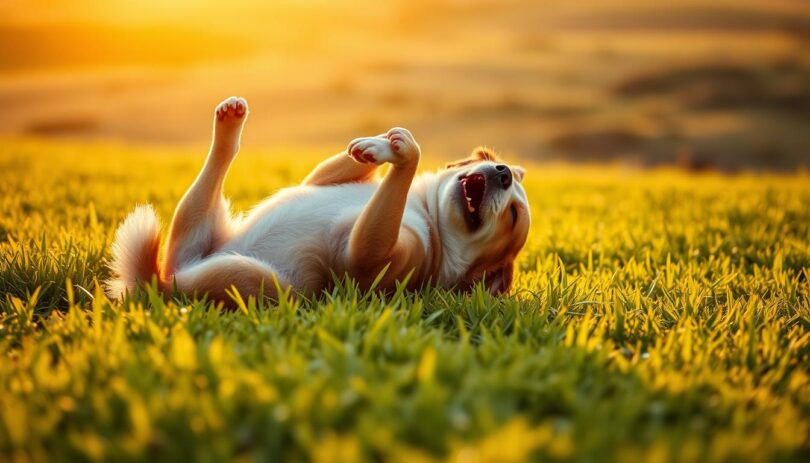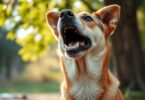Canines possess up to 300 million scent receptors—50 times more than humans. This biological superpower drives many quirky habits, including one that puzzles pet parents: joyful twisting on lawns and parks.
This instinctual activity serves multiple purposes. Experts like animal behavior researcher Miles Bensky note it helps animals interact with environmental odors, masking their natural scent or gathering information. Rolling allows them to carry traces of intriguing smells, a form of olfactory communication inherited from wild ancestors.
Evolution plays a role too. Wolves and other wild relatives historically used similar motions to disguise their presence during hunts. Modern pets retain this trait, though motivations now blend practicality with simple enjoyment. The physical act also offers relief from itching or skin irritation in some cases.
Understanding these actions requires examining biological roots and sensory experiences. Upcoming sections explore scientific insights, evolutionary connections, and tips for interpreting this common but fascinating habit.
The Science Behind a Dog's Roll in the Grass
Dogs experience the world through smells, influencing actions like rolling on lawns. This behavior blends biology, instinct, and physical needs—all working together to create a fascinating canine ritual.
Understanding Canine Scent Sensitivity
With 300 million scent receptors, canines detect odors humans can’t perceive. Rolling transfers environmental scents onto their fur, acting like a living message board. This helps them share information with other animals or simply enjoy intriguing smells.
Instinctual Triggers and Ancestral Behaviors
Wild ancestors used similar motions to mask their scent while hunting prey. Modern pets retain this trait, often rolling after detecting strong odors like earth or decaying matter. It’s a primal response to “collect” smells for later investigation.
How Rolling Affects Their Physical Well-being
The twisting motion stretches muscles and relieves joint stiffness. It can also scratch hard-to-reach areas, offering itch relief. Studies show this activity releases endorphins, promoting relaxation alongside its practical benefits.
Why Do Dogs Roll in the Grass: Uncovering Scent and Communication
A dog's world brims with invisible messages carried through smells. This silent language drives behaviors that might seem odd to humans but carry deep meaning for our four-legged companions. Let’s explore how scent interactions shape their daily routines.
Scent Masking, Marking, and Journaling Explained
Canines often twist across grassy areas to blend their natural odor with environmental scents. This practice traces back to wild ancestors like wolves, who disguised their presence while hunting. By coating their fur with new smells, they create a unique scent profile—a form of olfactory storytelling.
This “scent journaling” lets them share experiences with other animals. When your pet returns from exploring fascinating canine behaviors, they might be carrying aromatic notes about their adventure. It’s their way of leaving—and collecting—messages in nature’s open-air database.
Environmental Odors and Their Intriguing Effects
Fresh-cut grass or animal traces often trigger rolling motions. These smells provide sensory stimulation while offering physical relief. The cool blades can soothe itchy skin, combining comfort with curiosity.
Environmental factors like decaying leaves or insect pheromones add layers to this ritual. Each roll becomes a multi-sensory experience—scratching an itch while gathering intel about nearby creatures. It’s nature’s perfect blend of practicality and pleasure for our furry friends.
Practical Perspectives on Canine Grass-Rolling Behavior
Pet owners often wonder how to respond when their furry companion enthusiastically twists across the lawn. While this instinctual act is natural, recognizing its context helps balance safety with a pet’s needs.
Behavioral Insights and What It Means for Your Pet
Frequent rolling around grass might signal curiosity or scent exploration. Observe patterns—does your pet target specific areas? They could be gathering environmental information or reacting to hidden odors. Consistent scratching during these sessions may indicate skin irritation requiring attention.
Training Tips and Positive Reinforcement Techniques
Redirect undesired rolling with commands like “come” or “leave it,” rewarding compliance with treats. Create a designated digging zone if your pet associates grassy areas with play. Avoid scolding, as this may confuse them. Instead, reinforce alternative behaviors through short, engaging training sessions.
Managing Health, Allergies, and Itch Relief
Check for redness, hot spots, or excessive paw licking after outdoor adventures. Seasonal allergies often intensify rolling around grass. Consult a vet if symptoms persist. Regular grooming with hypoallergenic shampoos and omega-3 supplements can ease skin discomfort.
For scent-driven rollers, wipe paws and coats post-walk to remove irritants. Use pet-safe wipes for quick cleanups. Adjust routines during high-pollen seasons to minimize exposure while respecting their natural instincts.
Final Reflections on Dog Behavior and Grass-Rolling Habits
Understanding this quirky habit reveals a fascinating mix of biology and ancient instincts. Rolling across lawns often stems from a pet’s need to interact with environmental scents, blending ancestral communication with modern-day curiosity. This behavior ties to both instinct and physical needs—scratching an itch or stretching muscles while gathering olfactory information.
For most pets, occasional sessions are harmless and mentally stimulating. However, frequent rubbing paired with redness or excessive licking could signal skin irritation. Owners should note changes in patterns, as these might indicate allergies or dermatological concerns. Regular grooming with hypoallergenic shampoo helps manage sensitivities without suppressing natural behaviors.
Balancing observation with practical care strengthens the bond between humans and their companions. By recognizing when rolling shifts from playful to problematic, owners protect their pet’s health while respecting inherited traits. This dual approach—honoring instincts while addressing modern needs—offers deeper insights into canine behavior and promotes happier, healthier lives for our four-legged friends.
FAQ
Is rolling in grass a sign of skin irritation or allergies?
While occasional rolling is normal, frequent or obsessive behavior might indicate skin irritation, allergies, or parasites. Check for redness, rashes, or excessive scratching. Hypoallergenic shampoos like TropiClean or Veterinary Formula can help soothe sensitive skin.
How does scent masking relate to a dog’s prey drive?
Rolling in strong environmental odors (like animal scents) may mask a dog’s natural smell, helping them blend into their surroundings during hunting. This instinct traces back to wolves concealing their presence from prey.
Can training reduce excessive grass-rolling behavior?
Positive reinforcement techniques, such as redirecting with toys or treats like Zuke’s Mini Naturals, can help manage the habit. Consistency and rewarding alternative behaviors encourage better impulse control without suppressing natural instincts.










Leave a Comment